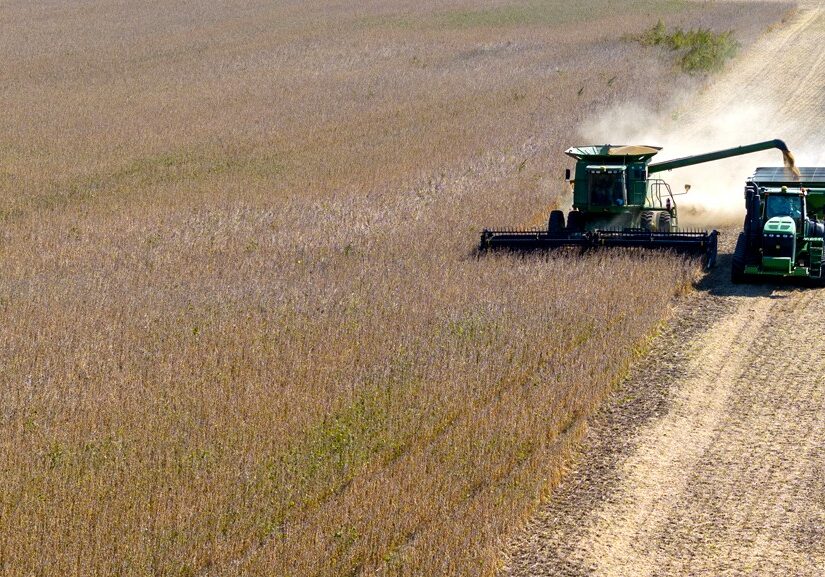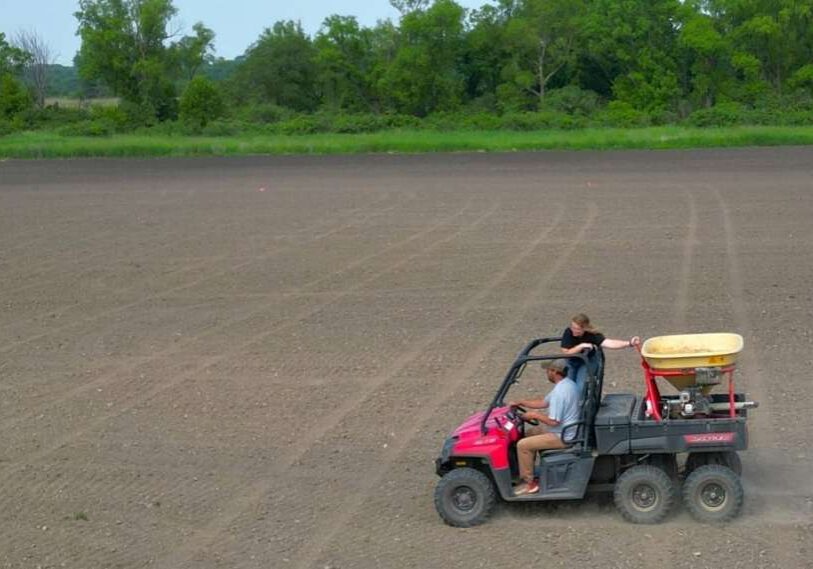Hydroponic Farm is High Tech Operation With Small Footprint

WYKOFF – Unlike most farmers who walk outside the door to view their crops, Tony Rahe (pronounced Ray) of Rahe of Sunshine Farms in Wykoff walks inside a door to tend to his beds of lettuce.
Instead of horizontal rows of crops planted in black soil as far as the eye can see, Rahe’s crops are planted vertically in a clean, compact space fed by constant drips of water.
Rather than being at the mercy of nature with its unpredictable weather, Rahe’s operation runs on Wi-Fi as the growing conditions are monitored by his iPad around the clock so that he has uniform light, moisture and nutrients that vary little from day to day.

Tony Rahe checks on the progress of his vertical crops. (Photo by David Phillips)
While typical crop farmers have completed their fall harvest and will soon be looking forward to spring planting, Rahe’s growing season never ends as he is on a rotating weekly schedule with continuous planting and harvesting cycles.
Rahe’s unusual operation is part of a growing movement of hydroponic, vertical, container farming.
His compact farm will produce about the equivalent of 84 acres of lettuce in 2024, yet most people drive right by his hydroponic operation at the edge of downtown Wykoff without realizing acres of lettuce are growing inside. That’s because his operation is fully enclosed in two semitrailers, the same units drivers see on the highway except without the wheels.
“I’ve got three-and-a-half acres in each container. That really blows my mind,” Rahe said. “It’s so neat to have such an impact on either the community, or the schools, or farmers markets and explain to them that I’ve got moving walls and I grow everything up and down.”

A view from the back side of Rahe of Sunshine Farms shows the exterior of the semi-trailers that house crops. (Photo by David Phillips)
Large output from small footprint
Rahe and his wife, Kelly, moved to Wykoff in 2020. Kelly, who has been in banking for 32 years, works at MinnWest Bank in Spring Valley while also helping out with the hydroponic operation. Tony, a veteran of Desert Shield/Storm while spending eight years in the Iowa National Guard, grew up on a 300-acre farm, studied horticulture in college and spent 25 years working on golf courses in Iowa and Minnesota.
He got out of turf management at golf courses in 2010 and now power washes hog farms while also volunteering for the Spring Valley Ambulance Service. However, in the last few years he developed an interest in getting back to his horticulture roots.
When asked why hydroponics, he quipped that he didn’t have any farmland. There is more to it than the lack of land, though. He first looked at hydroponic greenhouses before settling on hydroponic container farming, which he noted uses much less water than the golf courses he used to care for.
“The footprint on these really caught my eye,” he said. “We only use about five gallons of water to water three-and-a-half acres of lettuce a day. So, it’s very sustainable and the footprint is pretty small. My biggest footprint as far as the buildings, my containers, go, is electricity and we’re looking at solar panels, windmills or anything like that.”
The 40- by 8-foot semitrailers were modified for hydroponic farming by a company called Freight Farms, based in the Boston area. Each unit provides 320 square feet to grow the equivalent of three-and-a-half acres of lettuce along with a few other vegetables. Rahe harvests about seven acres of lettuce each month.
When he decided to get his first container in 2022, there was a lot buzz in Wykoff with one council member even trying to head off what he thought would be illegal activities behind the walls of his first semitrailer.
“‘How much weed are you growing?’ That was our biggest question,” he said. “I told Kelly, as a veteran I know weed does help for PTSD, but I don’t want to screw up the world any more than it is. I’ll let the doctors worry about that. I’ll just grow lettuce.”

Tony Rahe pops out a panel to show how the operation is very flexible. (Photo by David Phillips)
Self-contained, high tech operation
The plants in his hydroponic farm are grown vertically in PVC pipes with wicks that absorb a constant trickle of water to nourish the roots of his plants, which are mostly varieties of lettuce, but also radishes, kohlrabi, micro greens and other greens. The pipes are in panels that snap together on four moving 30-foot walls inside each semitrailer container.
He starts each of eight growing cycles by inserting seeds into small plugs in flats in a nursery at the front of each container.
After about three weeks, the seedlings are transferred to vertical poles. The plugs pop into the existing holes spaced out along the height of the poles with the bottom of each plug touching the wicks.

Plugs recently seeded are placed in the nursery. (Photo by David Phillips)

Seedlings are about ready to be transplanted to the panels on the moving walls of the farm. (Photo by David Phillips)
The operation is a continuous eight-week rotation. He harvests every Saturday or Sunday and delivers his produce every Monday. Then, Monday night he tears everything down in the section he harvested. Tuesday, he seeds 10 flats to start another eight-week growing cycle.
When he enters the units in the morning, he is greeted with a startling display of lights that have red and blue LED bulbs to aid growth. The red lights are on for 18 hours and the blue lights, which promote root growth, are on for 12 hours.
Rahe does some tours for agriculture classes and FFA groups. He noted that the students are “in awe” when they come in with the grow lights shining throughout the entire container, so he hears “a lot of oohs and aahs.”
Each container has a 40-gallon nursery tank of water in the front with an ebb and flow system. An 88-gallon cultivation tank in the back of each unit provides water to the maturing plants. It also uses an ebb and flow system, sending constant drips from the top of the panels to each wick inside the pipes that house the plants. The water flows through the entire length of the panel with the excess feeding into a trough that goes back into the cultivation tank to reuse the water.
He uses city water, although he has had to adjust the pH for better growing. Because nutrients are added to the water, at times he has to flush the water outside to a 55-gallon drum in the back of his units where the HVAC system is located. He reuses that water for other things, such as on his yard.
The powerful grow lights provide enough heat that he doesn’t use his heating system much in the winter. His units do require cooling in the summer, though. One modification made to the semitrailers is insulation, which helps keep the interior environment stable.
He has never had much of an insect problem, although he has made adjustments to the air movement to reduce humidity. He added a generator to his operation last year, his version of crop insurance.

Tony Rahe checks his iPad to monitor the conditions of his operation. (Photo by David Phillips)
He cleans the units often, so the units are usually spotless. He has to watch the conditions closely because lights and water could lead to algae problems.
Nearly everything he does is run off his tablet, or his phone when he is outside the units. He may get an alert about the watering system, a problem he may be able to take care of from his phone without entering the units.
Markets follow seasonal pattern
Although his crops maintain a constant cycle no matter the season, his markets vary through the year.
His online store has a fairly constant base of customers, but that is only a small portion of his sales. Still, this is an important group as it is mostly local residents, many of them from Spring Valley, which is convenient since Kelly works in the community and Tony volunteers for the local ambulance.
“Very seldom do we not leave town without orders in our cooler,” he said. Customers can also pick up their orders in person at the business in Wykoff.
In winter, most of his lettuce goes to area schools, which he said has been a good niche for them. He harvests about 215 pounds of lettuce each week to deliver to schools on Mondays.
“It’s good for us and it’s great for the students to get fresh lettuce, fresh kohlrabi and fresh radishes,” said Rahe.
His first school was St. Charles in 2023. Now, he has Pine Island, Cannon Falls, Zumbrota-Mazeppa and a few in the Twin Cities suburbs.
In the summer, he sells at farmers markets, including Lanesboro and Rochester. He sells about 150 pounds per week at the five to six markets he attends.

A mature lettuce head is harvested before preparations for delivery to a customer. (Photo by David Phillips)
Buyers at farmers markets often seek more varieties, so summer is when Rahe experiments with vegetables, growing varieties such as arugula, various herbs and kale. He grows up to 10 different lettuce varieties in the summer, an increase from his usual six.
“It’s crazy how much difference there is in taste of lettuce,” he said.
His standard lettuce offerings are three romaine varieties, such as breen, and three summer crisp varieties, such as muir. His signature offering to customers is what he calls the sunshine mix, which has a combination of all six annual lettuce varieties.
He also grows radishes throughout the year along with kohlrabi, which started as a “trial and error that ended up being a nice addition,” he said. He uses one panel each week to grow 45 kohlrabi, which are sometimes known as German turnip or turnip cabbage. They grow into solid baseball-size balls.
“I eat them raw,” he said. “I put a little salt on them for lunch. That’s how we grew up on them.” His wife cuts them up using a julienne cut to put in coleslaw or an Asian mix. Other people may sauté them like chestnuts.
Ideas continue to grow
Historical documentation of hydroponic growing dates back to the 1600s, although it was mostly experimental on a very small scale then. Advances were made over the centuries, particularly in the 20th century. Technological advances have led to major steps forward in recent years, leading to massive increases in hydroponics operations in the last decade.
Rahe did his research before taking the plunge. His wife was skeptical about hydroponics, but after the two attended a demonstration at Freight Farms headquarters, she came around. Today, Kelly helps often with harvesting and seeding, although Tony joked that she still leaves the cleaning to him.
The couple also visited some other Freight Farms operations, including one in Shoreview, Minn. The company, which has units in every state in the United States and more than 600 worldwide on five continents, has an extensive online knowledge base along with an online network for farmers to share information.

Behind the doors of this unassuming building near downtown Wykoff is a bountiful farm that produces acres of lettuce each year. The front is a reception/office area with the two semi trailers extending from the back of the street-facing building. (Photo by David Phillips)
Prior to going with Freight Farms, Rahe visited another hydroponic farm in southeastern Minnesota that uses a different system than the one he ultimately decided to use. The hydroponic operation of Andrew Serio on his property adjacent to Forestville/Mystery Cave State Park is a horizontal system in a greenhouse, which allows him to raise tomatoes. He also grows green and red lettuce varieties, basil and watercress.
Serio operates year-round, offering his vegetables at farmers markets, but also to local food businesses, restaurants and caterers, according to a post on the Rochester Farmers Market website. More information is on his Serio Farms website.
Once Rahe settled on a system, he then came up with what crops to grow after some trial and error. He wasn’t looking at lettuce when he started, but after experimenting with various things, he settled on the mix he has today, which he plans to continue.
Although his operation could grow just about anything, he said tomatoes and other vining plants are too difficult in a vertical system. The company notes that greens are the predominant crop for most of its farmers because they make the most efficient use of water and energy since nearly all the plant is edible.
At the start, he intended to have just one container, but an opportunity came up that he couldn’t pass so he purchased a second container in 2023. Now, he is considering more. He would like to eventually get two more containers, possibly stacking them if that is feasible.
If that does come to fruition, Rahe will add another unique characteristic to his operation: He will be the only farmer in the area to climb stairs to get to some of his crops.






